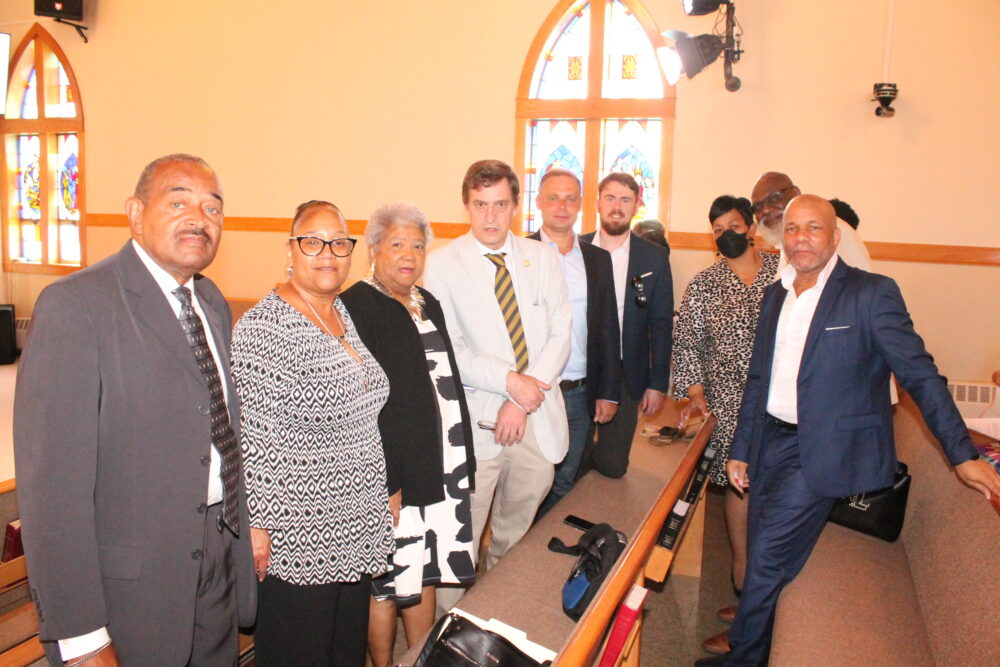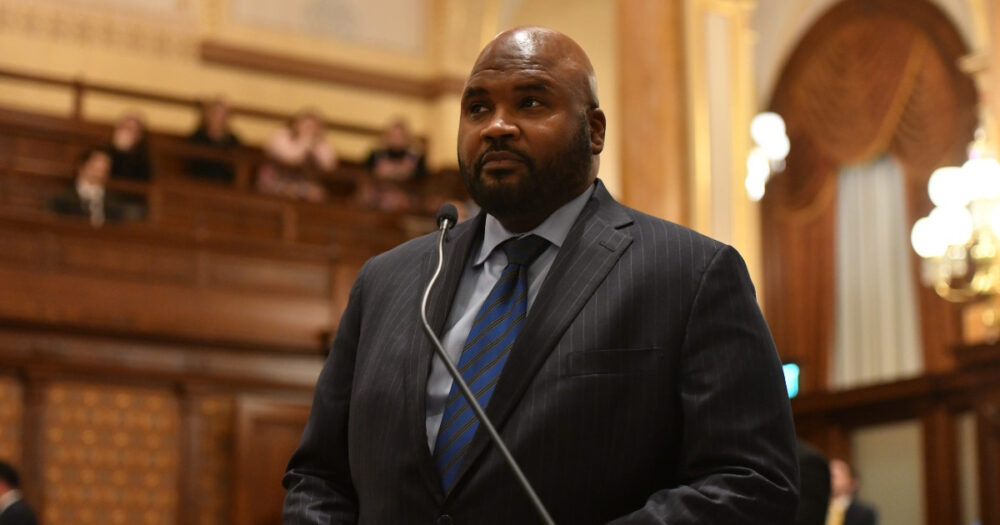Bettiola Fortson was only 26 when she died of tuberculosis at her home on south Prairie Avenue in Chicago, but she’d made a considerable mark in that short time.
Born in Kentucky to illiterate parents in the early 1890s, she would help found and lead a group focused on promoting artistic and literary pursuits among Black women, and was part of another prominent effort to secure voting rights for women alongside Ida B. Wells in the Alpha Suffrage Club.
Advertisement
In 1915, Bettiola Fortson published the book “Mental Pearls: Original Poems and Essays,” a work that was published again over eight decades later in the volume “Six Poets of Racial Uplift” in 1996.
Shortly after Wells gave a eulogy at Fortson’s funeral in April, 1917, Fortson’s remains were loaded aboard a southbound train to Thornton, where they were carried several blocks past the outskirts of town and interred in Mount Forest Cemetery, which had been established just a few years before.
Advertisement
Fortson, who had spent a good portion of her life campaigning for equality, wasn’t afforded it even after she died.
“African Americans had to deal with segregation in life, and they had to deal with segregation in death,” said Tammy Gibson, a travel historian who lives in Hazel Crest and has started an effort she calls “Black Graves Matter.”
“A majority of the white cemeteries wouldn’t allow African Americans to be buried there, and if they did, they were charged a higher rate,” she said.
In her extended family, that historically meant bringing the remains of loved ones from Chicago “back to Mississippi, where they had family and church cemeteries.”
Many people didn’t have that option, though, and faced with the rampant racism of the early 1900s, South Side church and business leaders implemented solutions, buying tracts of land where their loved ones could be buried in peace.
A group of African American business leaders established Mount Glenwood cemetery south of Thornton in 1908 and a year later, Olivet Baptist Church created Mount Forest cemetery just north of the village. In the 1920s, two more traditionally African American cemeteries opened in the Alsip area, Restvale and Burr Oak.
Those first African American burial grounds flanked Thornton, a village still known mostly for its giant hole in the ground where limestone has been extracted for a century and a half. When those cemeteries were established, Thornton also was also a place where very few, if any, Black people lived.
Debbie Lamoureux, of the Thornton Historical Society, said African American people probably worked at the quarry, but the sites for Mount Forest and Mount Glenwood more likely were chosen because of railway access from the South Side via the Chicago and Eastern Illinois.
Advertisement
Plus, the area then qualified as “the boonies.”
“It was outside of town,” she said. “Thornton people couldn’t say anything about it.”
In an oral history, Lamoureux said, a resident recalled hundreds of people getting off the train at Thornton depot when Olivet’s pastor died, accompanying his remains to Mount Forest. Mount Glenwood, she said, had a dedicated rail siding and there were scheduled trips where a passenger car would be left for the day while South Side residents visited with the departed.
“It would be an all-day affair, because they came a long way,” she said. “Thornton was the middle of nowhere — there were dirt roads.”
She interviewed a woman born in 1912 whose father was cemetery caretaker and whose mother used to cook meals for the visitors and “sell them for pennies.”
“People would walk to their house, buy food and have a picnic,” she said.
Advertisement
Those picnics were and continue to be “celebrations,” said Gibson, who still heads to graveyards every time she gets the chance.
“Cemeteries are a place of history, and a place to visit ancestors,” she said.
Mount Forest closed in 1939 and was eventually abandoned. Records indicate many of the burials were relocated to Mount Glenwood after that, but several grave markers remain, including that of Bettiola Fortson, which still prominently displays the phrase “Mental Pearl.” Some of the actual graves may remain as well. Nobody is sure what is still underground there.

Before it closed, Mount Forest was home to the remains of World War I veterans and victims of the Spanish Flu Pandemic of 1918. Pullman Porters were buried there and one of the remaining tombstones records the tragic death of a 5-year-old girl.
The abandoned cemetery was eventually acquired and fenced off by the Forest Preserves of Cook County, which already owned an adjacent property called the Thornton Preserve. But the fence is easy to defeat, and those buried at Mount Forest have become ingrained in the consciousness of some residents in Thornton.
“There’s a man in town who every year decorates the grave of the little girl, and puts flowers and toys in there,” Lamoureux said.
Advertisement
While the remaining stones at Mount Forest aren’t in the best of shape, and dead limbs litter the ground between them, the grass hasn’t been allowed to get too high, and some upkeep by the county is obvious.
That’s not the same at other African American cemeteries Gibson has visited around the country, leading to her Black Graves Matter effort.
“I see lots of disrespect,” she said. “I’ve been to cemeteries where I’ve found dog feces. I’ve seen graffiti. I’ve seen cemeteries used as dumping grounds, with mattresses and garbage. Drug paraphernalia.
“I just want to make sure Black cemeteries are taken care of the same way as white cemeteries. I want to see proper funding to maintain the grounds, and more volunteers to come and do cleanups.”
She visits Mount Glenwood regularly, notifies management there if anything is amiss, and said they’re always responsive. In other areas, though, she’s encountered “people who were having a hard time trying to reclaim their ancestors’ graves, getting pushback from those who own the land or dealing with cities and counties that aren’t helping them.”
“That still happens today, and there’s still work that needs to be done,” she said. “But with social media, we can use that tool to highlight what’s going on.”
Advertisement

It’s an issue faced by many cemeteries, regardless of their preferred clientele. On the other side of the quarry, the Thornton Township cemetery on Ridge Road, which began as the regional burial ground after land was acquired from early entrepreneur Gurdon Hubbard in the 1850s, was in shambles a little over a century later.
“There was lots of vandalism,” Lamoureux said, noting by the 1980s and ‘90s “it was totally unkempt and stones were pushed over.”
“Then the (Thornton) township realized they owned it and started cutting the grass and fenced it in,” she said.
Daily Southtown
Twice-weekly
News updates from the south suburbs delivered every Monday and Wednesday
Now surrounded by a chain-link barrier topped with barbed wire, it’s open to visitors by appointment only.
Despite Thornton’s famed deep quarry, its desirability as a place to live — people have resided there since prehistoric times — is due to its high ground atop an ancient shoreline that’s still reflected in the names of Mount Forest and Mount Glenwood, as well as Ridge Road, the main drag leading to and from town.
It’s where sand washed up on the shores of ancient Lake Chicago when glaciers clogged up the northern reaches of what would become the Great Lakes. And it’s what made the sandy, loose soil so conducive to grave sites.
Advertisement
Regardless of the geology, to Gibson, the burial grounds surrounding Thornton are a place to celebrate the past, and a place to commune with one’s family history.
And she has a question.
“Have you checked on your ancestors lately?”
Landmarks is a weekly column by Paul Eisenberg exploring the people, places and things that have left an indelible mark on the Southland. He can be reached at peisenberg@tribpub.com.







